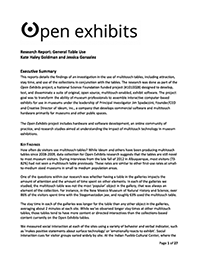
How often do visitors use multitouch tables? While Ideum and others have been producing multitouch tables since 2008-2009, data collection for Open Exhibits research suggests that the tables are still novel to most museum visitors. During interviews from the late fall of 2012 in Albuquerque, most visitors (73-82%) had not seen a multitouch table previously. These rates are similar to other first-use rates at small-to-medium sized museums in small to medium population areas.
One of the questions within our research was whether having a table in the galleries impacts the amount of attention and the amount of time spent on other elements. In each of the galleries we studied, the multitouch table was not the most ‘popular’ object in the gallery, that was always an element of the collection. For instance, in the New Mexico Museum of Natural History and Science, over 86% of the visitors spent time with the Stegomastodon jaw, and roughly 63% used the multitouch table.
The stay time in each of the galleries was longer for the table than any other object in the galleries, averaging about 2 minutes at each site. While we’ve observed longer stay times at other multitouch tables, those tables tend to have more content or directed interactives than the collections-based content currently on the Open Exhibits tables.
We measured social interaction at each of the sites using a variety of behavior and verbal indicator, such as ‘makes positive statements about surface technology’ or ‘emotionally reacts to exhibit’. Social interaction cues for visitor groups varied widely by site. At the Indian Pueblo Cultural Center, where the table primarily controls access to short videos, 25% of the visitor groups had some form of social interaction. In comparison, at NMMNHS 80% of the visitor groups showed some form of social interaction.